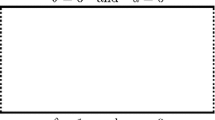Abstract
We consider a recently introduced continuous data assimilation (CDA) approach for downscaling a coarse resolution configuration of the 2D Bénard convection equations into a finer grid. In this CDA, a nudging term, estimated as the misfit between some interpolants of the assimilated coarse-grid measurements and the fine-grid model solution, is added to the model equations to constrain the model. The main contribution of this study is a performance analysis of CDA for downscaling measurements of temperature and velocity. These measurements are assimilated either separately or simultaneously, and the results are compared against those resulting from the standard point-to-point nudging approach (NA). Our numerical results suggest that the CDA solution outperforms that of NA, always converging to the true solution when the velocity is assimilated as has been theoretically proven. Assimilation of temperature measurements only may not always recover the true state as demonstrated in the case study. Various runs are conducted to evaluate the sensitivity of CDA to noise in the measurements, the size, and the time frequency of the measured grid, suggesting a more robust behavior of CDA compared to that of NA.
Similar content being viewed by others
References
Timbal, A., Dufour, A., McAvaney, B.: An estimate of future climate change for Western France using a statistical downscaling technique. Climate Dyn. 20, 807–823 (2003)
Hewitson, B. C., Crane, R. G.: Consensus between GCM climate change projections with empirical downscaling: precipitation downscaling over South Africa. Int. J. Climatol. 26, 1315–1337 (2006)
Gutzler, D. S., Robbins, T. O.: Climate variability and projected change in the western United States: regional downscaling and drought statistics. Clim. Dyn. 37, 835–849 (2011)
Jha, S. K., Mariethoz, G., Evans, J., McCabe, M. F., Sharma, A.: A space and time scale-dependent nonlinear geostatistical approach for downscaling daily precipitation and temperature. Water Resour. Res. 51(8), 6244–6261 (2015)
Guiterrez, J. M., San-Martin, D., Brands, S., Manzanas, R., Herrera, S.: Reassessing statistical downscaling techniques for their robust application under climate change conditions. J. Climate 26, 171–188 (2013)
McGregor, J.: Regional climate modelling. Meteorol. Atmos. Phys. 63, 105–117 (1997)
Liu, P., Tsimpidi, A. P., Hu, Y., Stone, B., Russell, A. G., Nenes, A.: Differences between downscaling with spectral and grid nudging using WRF. Atmos. Chem. Phys. 12, 3601–3610 (2012)
Feser, F., Barcikowska, M.: The influence of spectral nudging on typhoon formation in regional climate models. Environ. Res. Lett. 1, 014024 (2012)
Lo, C. J., Yang, Z. L., Pielke, R. A.: Assessment of three dynamical climate downscaling methods using the weather research and forecasting (WRF) model. J. Geophys. Res. 113, D09112 (2012)
Wilby, R., Wigley, L. T. M. L.: Downscaling general circulation model output: a review of methods and limitations. Prog. Phys. Geog. 21, 530—548 (1997)
Murphy, J.: An evaluation of statistical and dynamical techniques for downscaling local climate. J. Climate 12, 2256–2284 (1999)
Bennet, A.: Inverse Methods in Physical Oceanography, p 346. Cambridge University Press, Cambridge, UK (1992)
Altaf, M. U., Butler, T., Mayo, T., Luo, X., Dawson, C., Heemink, A. W., Hoteit, I.: A comparison of ensemble Kalman filters for storm surge assimilation. Mon. Wea Rev. 142, 2889– 2914 (2014)
Altaf, M. U., Ambrozic, M., McCabe, M. F., Hoteit, I.: A study of reduced-order 4DVAR with a finite element shallow water model. Int. J. Numer. Methods Fluids 80, 631–647 (2016)
Charney, J., Halem, J., Jastrow, M.: Use of incomplete historical data to infer the present state of the atmosphere. J. Atmos. Sci. 26, 1160–1163 (1969)
Daley, R.: Atmospheric Data Analysis. Cambridge Atmospheric and Space Science Series, Cambridge University Press, Cambridge (1991)
Henshaw, W. D., Kreiss, H. O., Ystrom, J.: Numerical experiments on the interaction between the large and small scale motion of the Navier Stokes equations. SIAM J. Multiscale Modeling Simulation 1, 119–149 (2003)
Olson, E., Titi, E. S.: Determining modes for continuous data assimilation in 2D turbulence. J. Stat. Phys. 113, 799– 840 (2003)
Olson, E., Titi, E. S.: Determining modes and Grashoff number in 2D turbulence. Theor. Comput. Fluid Dyn. 22, 327–339 (2009)
Korn, P.: Data assimilation for the Navier-Stokes- α equations. Physica D 238, 1957–1974 (2009)
Hayden, K., Olson, E., Titi, E.S.: Discrete data assimilation in the Lorenz and 2D Navier–Stokes equations. Physica D 240, 1416–1425 (2011)
Azouani, A., Olson, E., Titi, E. S.: Continuous data assimilation using general interpolant observables. J. Nonlinear Sci. 24, 277–304 (2014)
Bessaih, H., Olson, E., Titi, E. S.: Continuous assimilation of data with stochastic noise. Nonlinearity 28, 729–753 (2015)
Farhat, A., Lunasin, E., Titi, E. S.: Abridged continuous data assimilation for the 2D Navier-Stokes equations utilizing measurements of only one component of the velocity field. J. Math. Fluid Mech. 18, 1–23 (2016)
Farhat, A., Lunasin, E., Titi, E. S.: Data assimilation algorithm for 3D Bénard convection in porous media employing only temperature measurements. J. Math. Anal. Appl. 438, 492–506 (2016)
Gesho, M., Olson, E., Titi, E. S.: A computational study of a data assimilation algorithm for the two-dimensional Navier–Stokes equations. Communications in Computational Physics 19, 1094–1110 (2016)
Farhat, A., Jolly, M. S., Titi, E. S.: Continuous data assimilation for the 2D Bénard convection through velocity measurements alone. Phys. D 303, 59–66 (2015)
Ghil, M., Shkoller, B., Yangarber, V.: A balanced diagnostic system compatible with a barotropic prognostic model. Mon. Wea. Rev. 105, 1223–1238 (1977)
Ghil, M., Halem, M., Atlas, R.: Time-continuous assimilation of remote-sounding data and its effect on weather forecasting. Mon. Wea. Rev. 106, 140–171 (1978)
Hoke, J., Anthes, R.: The initialization of numerical models by a dynamic relaxation technique. Mon. Wea. Rev. 104, 1551–1556 (1976)
Aswatha, C. J., Gowda, G., Sridhara, S. N., Seetharamu, K. N.: Buoyancy driven heat transfer in cavities subjected to thermal boundary conditions at bottom wall. Journal of Applied Fluid Mechanics 5, 43–53 (2012)
Author information
Authors and Affiliations
Corresponding author
Rights and permissions
About this article
Cite this article
Altaf, M.U., Titi, E.S., Gebrael, T. et al. Downscaling the 2D Bénard convection equations using continuous data assimilation. Comput Geosci 21, 393–410 (2017). https://doi.org/10.1007/s10596-017-9619-2
Received:
Accepted:
Published:
Issue Date:
DOI: https://doi.org/10.1007/s10596-017-9619-2



